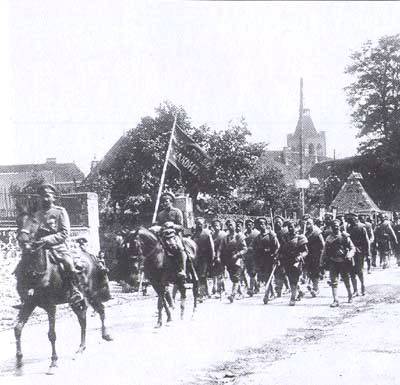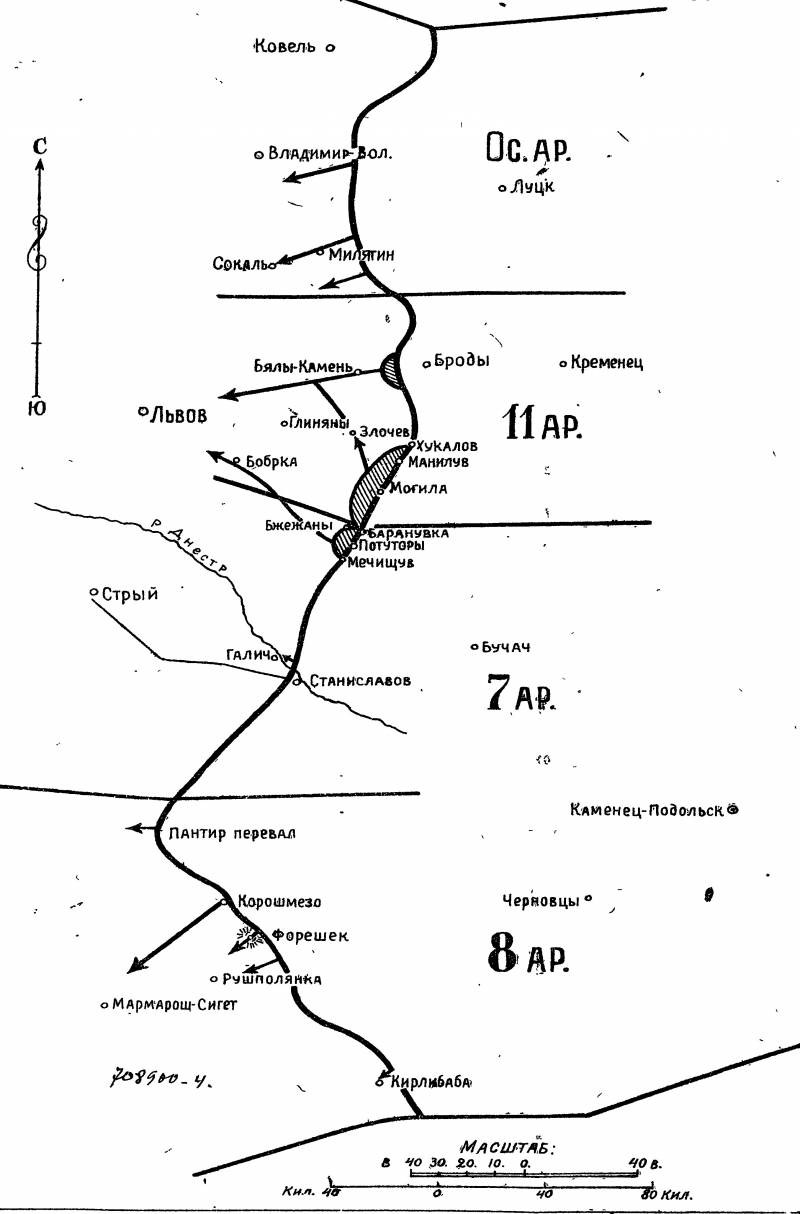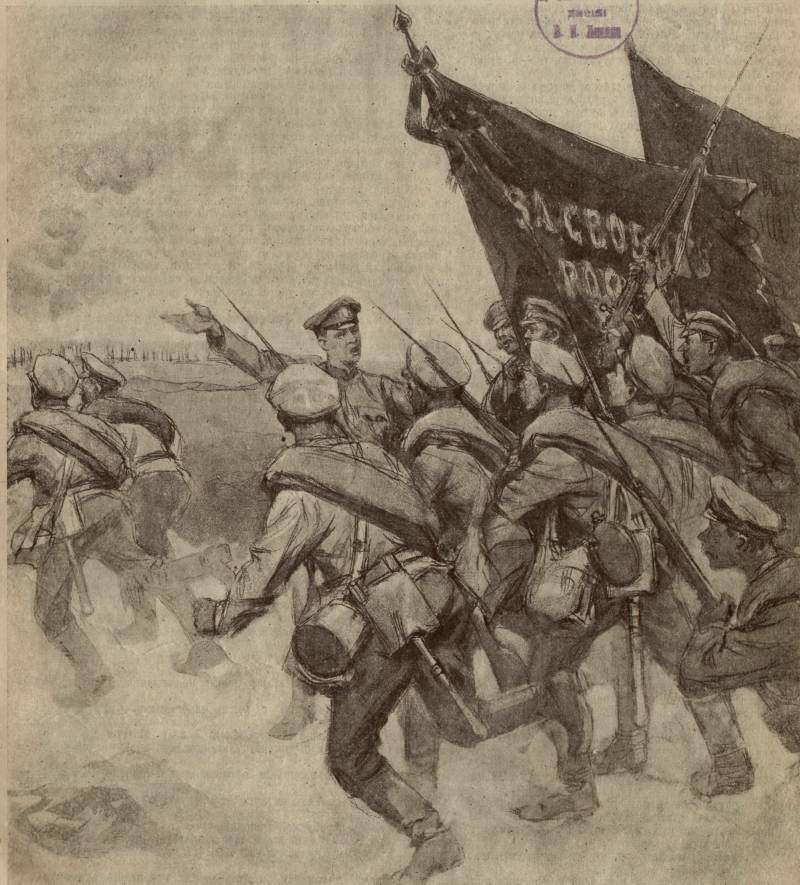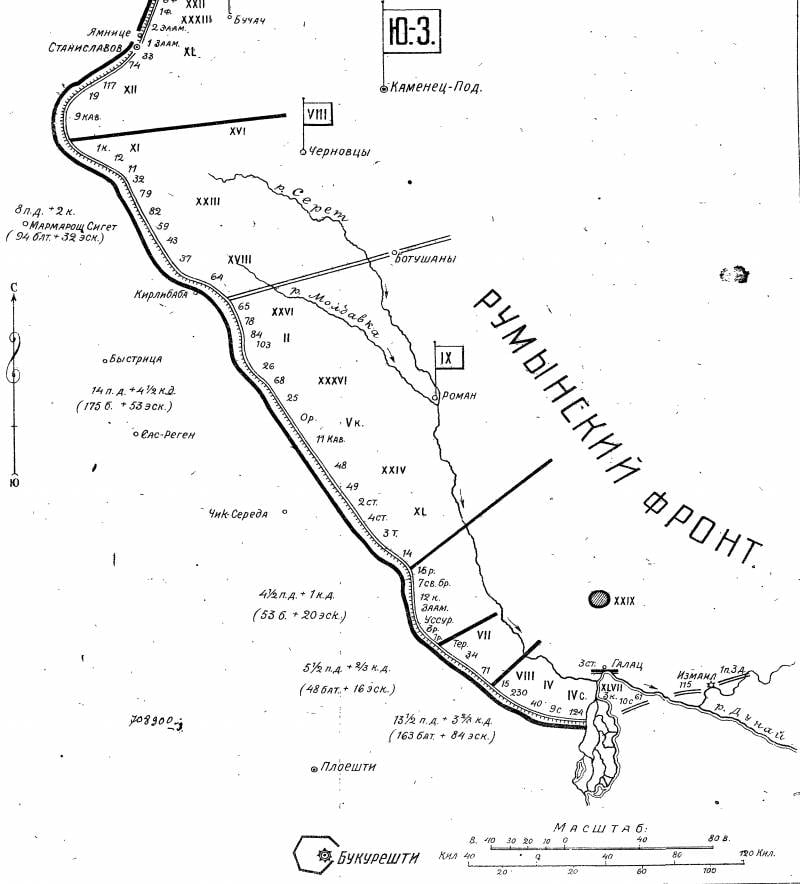TVD Second Patriotic. 1917 year. Part of 2
This theater in the summer of 1917 was of central importance in the campaign - and it was precisely the outcome of the summer offensive that depended largely on the fate of the summer offensive. The South-Western Front delivered the main attack.
During the Summer Offensive of his 4 army attacked: 11-I - at Lviv, 7-I - at Bobrki (from two sides covering the Austrian 2-th and the German Southern Army), 8-I - at Kalush and Bolekhuv (rejecting the Austrian 3- Army for the Stryi River), and the Special Bind Forced Army Group A. von Linzingen.
Having begun successfully, the Summer Offensive (see The last spurt. The June offensive of the South-Western Front 1917 r. 3. Offensive and its results) had negative results.
5 schema. The South-Western Front and the plans of the 1917 Summer Offensive. Strategic essay. H. 7
3. Attack in 1917
In the largest operation of the 1917 campaign, the enemy lost 82000 people, 121 guns and 403 machine guns, and the South-Western Front 18. 06. - 06. 07. - 58000 man, 257 guns and 546 machine guns.

4. Death battalion of the 3 Caucasian Army Corps
The Galician TVD was also central during this campaign, both in terms of the amount of forces and assets involved and of strategic implications. The troops in the remaining theaters during the Summer Offensive performed auxiliary tasks.
By the beginning of the campaign in this XDUMX theater unit, the Russian and 3 Romanian armies opposed the German 1, the Austrian 3 and the Bulgarian 1 armies.
6 schema. Romanian front. Strategic essay. H. 7
The July offensive of the Romanian 2 and Russian 4 armies of the Russian-Romanian front (see Salvation unlucky ally) on Mareshti was successful. The losses for July-August only cost the Germans 47000 people (without the Austrians and Bulgarians), and the total losses of the Russian-Romanian troops over 52000 people.
By the beginning of the 1917 campaign, the imperial headquarters clearly saw the promise of the Romanian theater, but the High Command in the post-revolutionary period overlooked the ever-increasing strategic importance of this theater (especially in July-August) and could not increase its strategic efforts in this very promising and successful in this period fighting, theater.
Because of the harsh winter, the Caucasian army did not conduct active operations. In early March, the 1-th Caucasian Cavalry Corps, defeating the Persian enemy grouping, captured the city of Kermanshah and an important communication hub of Sinnah, after which it moved towards Euphrates towards the allies - the British. And in the middle of the same month, 1-I Caucasian Cossack and 3-I Kuban divisions, having passed over 400 km, met with allies in Iraq - at Kyzyl Rabat. Turkey lost Mesopotamia.
Scheduled for 1917, the actions of the troops of the Caucasian Army were to become a model of interaction with the allies. Thus, operations were originally planned in close cooperation with the British (expeditionary army of General F. S. Moda). The plan provided for a powerful blow to the Turkish troops (to prevent the transfer of enemy troops to the Balkans and Galicia), as well as offensive operations on the Mesopotamian front. The actions of N. N. Baratov's group led to the establishment of elbow interaction with the allies and the emergence of another inter-union front. It was planned to form the 2 Caucasian Army, headed by the aforementioned general, as part of the Caucasian Front - the direction was so important.
Thus, since March 1917, the British and Russian troops acted together. Preparations for the Mosul operation began - the 1-th Caucasian Cavalry and 7-th Caucasian Army Corps were to take part in it. The offensive, which was to be conducted in close cooperation with the British, was planned for June. But, given the progressive revolutionary collapse of the army, the operation was postponed - until the spring of 1918, the Mosul operation could well become the most vivid example of direct combat cooperation of large Entente contingents on the same theater (the British even took on the issue of supplying the left flank of the Russian assault force). After the conclusion of a truce with the German bloc in December of 1917, the fighting of the Caucasian army ceased completely.
Thus, in the course of the 1917 campaign, the Galician TVD performed a striking task, while the rest of the theater operations were auxiliary. The key trend was the shift of the strategic importance of theaters to the flanks of the Austro-German front, to the Romanian and Baltic-Belarusian theaters. However, the High Command of the Russian army, which was in a state of revolutionary personnel leapfrog, could not make out this important fact, which was one of the reasons for the sad military outcome of the campaign.
It is obvious that there was no possibility to implement strategic planning in the post-revolutionary conditions - and the decline in the combat capability of the Russian troops had a great influence on the course and results of the campaign. But even in a situation of loss of combat capability, the Russian army continued to hold significant enemy forces in its theaters. Moreover, add additional resources. Thus, it was only during the Summer Offensive that the enemy redeployed to the east to 13 German (of which 11 from the French front) and 3 Austrian (from the Italian front) divisions.
In 1917, on the Russian front, the enemy suffered the following general losses: the Germans before 350000 (with 900000 on other fronts), and the Austrians around 150000 (with 316000 on other fronts) people. The total loss of Russian troops - up to 400000 people. During the campaign, Russian troops captured serious trophies - 120000 prisoners (up to 100000 Austrians and more 20000 Germans), 200 guns and up to 500 machine guns.
Bringing the brunt of the war in the most difficult years, Russia was left without a laurel winner. But even though 3 March 1918, only 8 months before the Entente ended the war, after the signing of the Brest-Litovsk peace treaty between the RSFSR and the Central Powers, it left the war, the theater of the former Eastern Front continued to hold a large number of German-Austrian troops.
Only the Germans kept here very large forces - even during the period of momentous and heavy battles in France in the spring-summer of 1918 (50 infantry divisions). These former theaters of the former Russian front rendered invaluable and last aid to the former allies. These divisions did not have enough E. von Ludendorff in the last spurt of the Kaiser army to Paris - and their absence at the key moment on the French front was a fatal circumstance for the enemy and his last strategic mistake.



Information